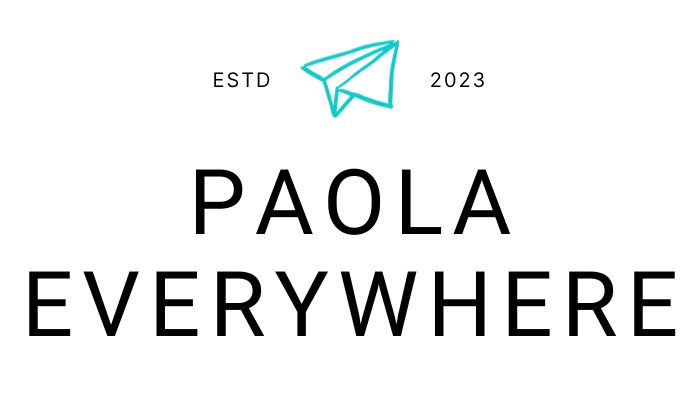Varallo, located in the heart of Valsesia, is best known for its UNESCO-listed Sacro Monte sanctuary. However, the town has much more to offer. Just a few hours’ drive from Milan or Turin, you will find a lush oasis where elegant historic buildings coexist with top-notch art museums. This serene environment invites you to slow down and enjoy a quieter corner of Piedmont.
Table of Contents
Varallo: A Belle Époque Town in the Heart of Valsesia
Varallo has its roots in the medieval period, but its urban character is distinctly 19th century. Once part of the Duchy of Milan, the town began to flourish in 1814 when it became part of Piedmont and the official capital of the Valsesia region.
PLAN YOUR TRIP TO ITALY
Stay connected on the go with a Holafly eSIM, offering unlimited data at reliable 3G, 4G, and LTE speeds across Italy.
For added peace of mind during your travels, take out Heymondo travel insurance, perfect for a stress-free and well-protected adventure.
If you plan to explore beyond the main cities, renting a car is the best way to discover Italy’s hidden gems at your own pace.
During this period, the Sacro Monte sanctuary gained popularity as a travel destination, largely thanks to the English Murray guidebooks, which were the equivalent of today’s Lonely Planet. Inspired by these recommendations, nobles and middle-class travellers flocked to the area for their holidays.
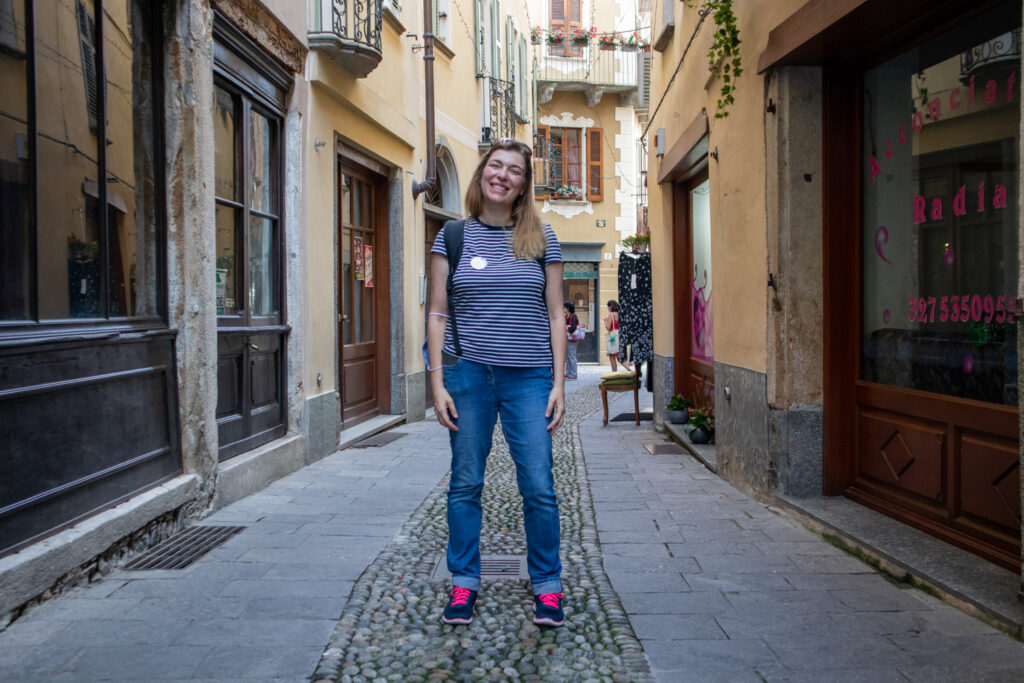
By the late 1800s, Varallo had established itself as a luxurious retreat, complete with a hydrotherapy spa, a railway connection to Novara (now closed), and one of the earliest public lighting systems in the region. Today, the elegant villas and grand townhouses are the only remnants of its Belle Époque heyday.
While the UNESCO-listed Sacro Monte and the masterpieces of Gaudenzio Ferrari are major attractions, I recommend taking some time to wander through the town and admire its architecture. Be sure to look for typical features, such as lowered top floors and Ionian-style capitals, subtle reminders of the town’s refined past.
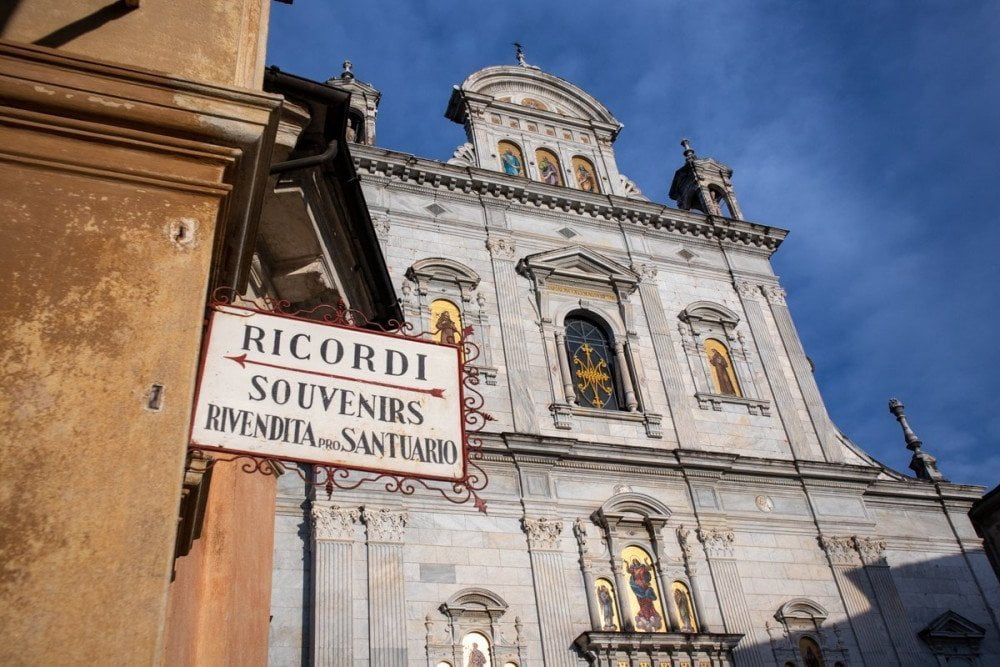
What to See in Varallo Sesia Besides the Sacro Monte
Varallo Sesia is a small, charming town that’s easy to explore on foot. To help you get your bearings and plan your visit, I recommend stopping by the local Tourist Office to pick up a map.
Many of the town’s sights reflect its rich history as both a popular travel destination and a place of pilgrimage to the Sacro Monte. But Varallo’s charm goes beyond its religious significance.
As you stroll through the town centre, you’ll come across striking murals by contemporary artists. These are part of the WARAL Art Urban Project, which connects the local tradition of fresco painting to modern street art, creating a vibrant open-air gallery.
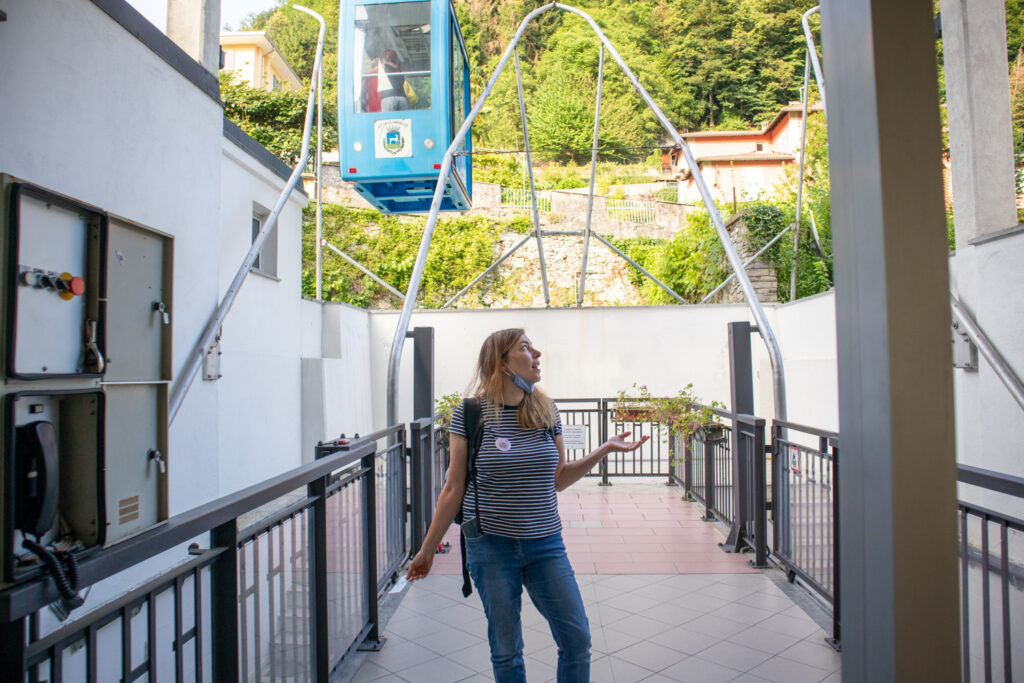
Don’t miss the historic cable car, either. Recently renovated, it carries visitors from the Church of Santa Maria delle Grazie to the Sacro Monte in just over a minute. But it’s more than just a means of transport as it’s an experience in itself, holding the record as the steepest cable car in Europe.
Finally, if you’re in Varallo on a hot day, do as the locals do: head to the little beach along the Mastallone stream. It’s the perfect spot to relax in the sun and cool off with a swim in crystal-clear mountain water.
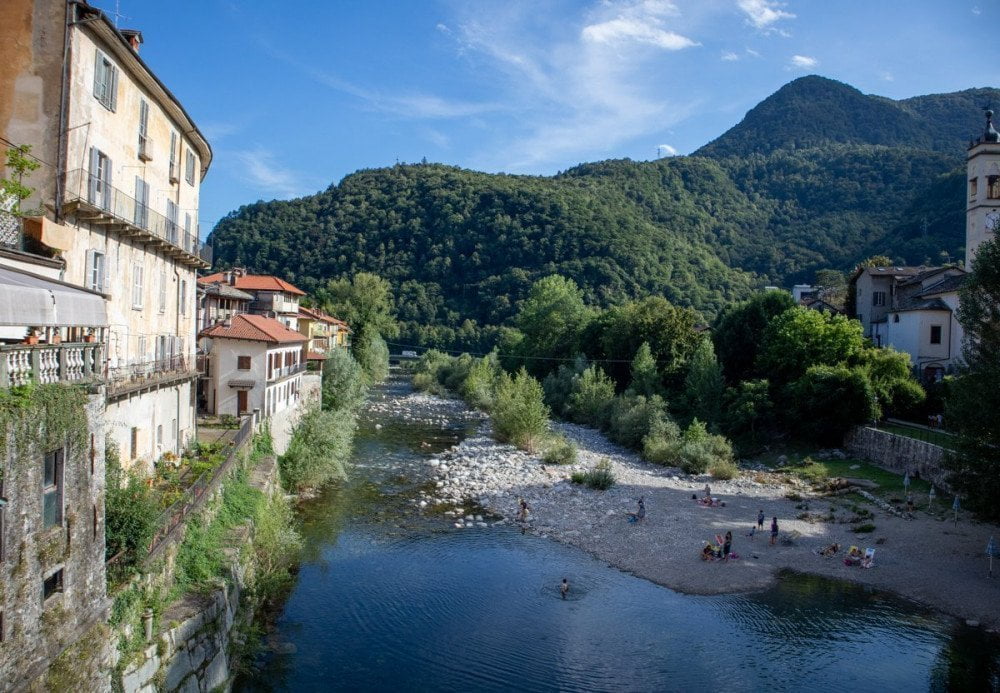
The Collegiate Church of San Gaudenzio
As you wander through the center of Varallo Sesia, you’ll notice the Collegiate Church of San Gaudenzio. This impressive complex sits on a rocky outcrop. It is easily recognized by its grand staircase and loggia, which features Ionic capitals, a hallmark of Valsesia architecture.
Over the centuries, the church has served many purposes. It has functioned as a church, guesthouse, and oratory. Inside, you can admire the polyptych of the Marriage of Saint Catherine. This remarkable work is by Gaudenzio Ferrari and is displayed in the church’s apse.
The Church of Santa Maria delle Grazie
In addition to the Sacro Monte, the Church of Santa Maria delle Grazie is another significant landmark linked to Bernardino Caimi’s vision of a new Jerusalem in Valsesia.
Built in the late 15th century, it is now a national monument. The church is famous for the Gaudenzian Wall, a monumental fresco depicting twenty-one scenes from the life of Christ.
This work is a remarkable example of sacred storytelling in Italian Renaissance art and is a must-see for visitors to Varallo.
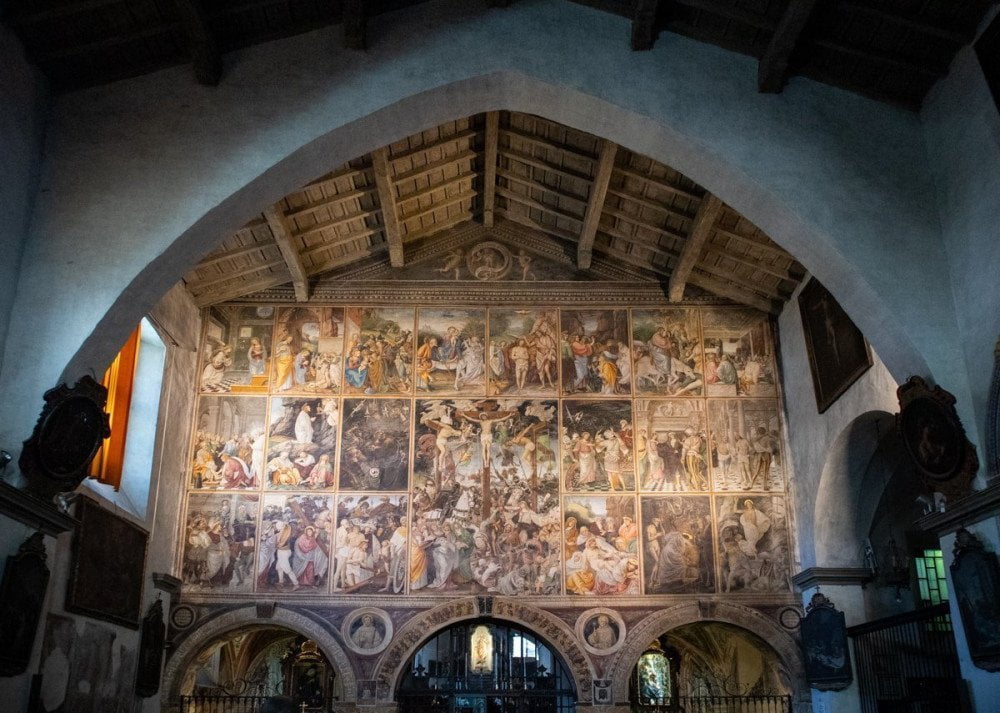
Casa Muntisel
In Varallo’s public park, you will find Casa Muntisel, a faithful reconstruction of a traditional Valsesian house. This typical rural dwelling features a roof made of beole, flat stone slabs commonly used in the region instead of terracotta tiles.
The house provides insight into past generations’ daily life and architecture, making it a fascinating stop during your walk through town.
Varallo’s Museums
If you plan to spend a few days in Varallo, visit the Palazzo dei Musei. This 19th-century building houses the Varallo Art Gallery (Pinacoteca) and the Pietro Calderini Museum of Natural History.
The Pinacoteca features paintings from the Piedmont and Valsesia regions. Many of these artworks are connected to the artistic development of the nearby Sacro Monte. Meanwhile, the Pietro Calderini Museum of Natural History explores the natural and geological history of the valley. It is perfect for curious travellers of all ages.
There are also several other museums to explore in town. The Cesare Scaglia House Museum is dedicated to the life and work of this local artist. The Museum of Energy showcases steam machines used in cotton processing. Lastly, the Fishing Museum at Palazzo Scarognini d’Adda offers insights into traditional Valsesian fishing techniques.
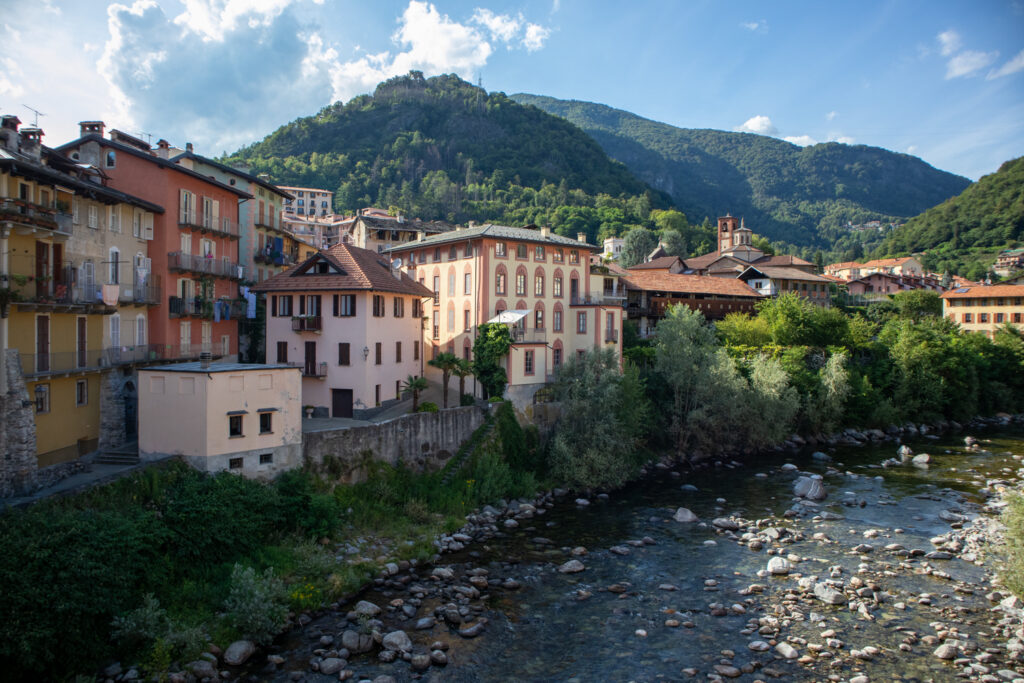
Culinary Delights and Wine Experiences in Varallo
Varallo’s cuisine brings together the flavours and traditions of the surrounding Alpine valleys. One of the area’s most iconic products is Toma Valsesiana, a strong mountain cheese often flavoured with spices, garlic, or chilli. It’s a robust cheese with a bold character, perfect for those who love intense mountain flavours.
Toma is also a key ingredient in miacce, a thin, crunchy flatbread cooked between two hot metal plates over an open flame. These rustic treats can be savoury, with cheese and cured meats, or sweet, filled with jam or honey for a lighter bite.
Other typical dishes from the Valsesia area include polenta concia (a rich polenta cooked with cheese and butter), capuneit (small meat rolls wrapped in cabbage or rhubarb leaves), and alegru, delicate almond and dark chocolate biscuits typical of Varallo.

Artisanal Treasures of Varallo Sesia: About Local Crafts
If you’re looking for an authentic local souvenir from Varallo, consider exploring Valsesian crafts. Start with the puncetto valsesiano, a handcrafted geometric lace made with needle and thread through a complex series of tiny knots.
Once highly valued by Savoy princesses and noblewomen, it was frequently included in royal trousseaux. Due to the intricate and time-consuming technique, authentic puncetto is quite expensive. You’ll find more affordable items like earrings and small decorative pieces.
Another traditional item is the scapin, a typical Valsesian slipper of Walser origin, handmade from hemp rope and fabric scraps. Originally designed as a durable and comfortable shoe for mountain life, the scapin is now enjoying a revival thanks to its low environmental impact and artisanal charm.
Varallo is also known for its traditional wood carving and soapstone work, crafts deeply rooted in local heritage and still practised by skilled artisans who pass down their knowledge from one generation to the next. These artisanal techniques are not only a testament to the valley’s creativity but also a beautiful reflection of its cultural identity.
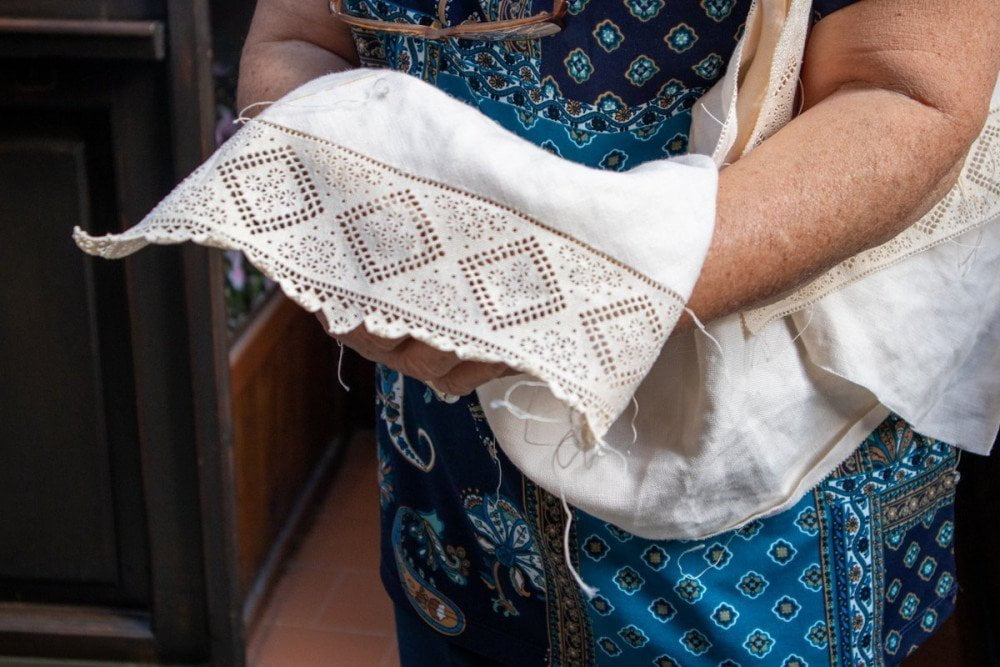
How to Get to Varallo Sesia
Reaching Varallo Sesia by public transport isn’t the easiest task. The Varallo railway line is now decommissioned and only used for historical trains on special occasions.
If you’re relying on public transport, your best option is to take a train or bus to Vercelli, then catch the bus number 50 which runs from Vercelli to Varallo.
There are no direct buses from Milan or Turin, so you’ll have to change at Vercelli, unless you join an organised tour to the Sacro Monte departing from your city.
However, the most convenient way to explore the area is by car. Valsesia is relatively remote, so if you don’t have your own vehicle, consider renting a car.
To get to Varallo by car, take the motorway to the Romagnano Sesia exit, then follow the Strada Provinciale 299 all the way to Varallo. Use Google Maps to check the best route based on traffic and your starting point.
Let me know in the comments if you had already heard of Varallo, or if this article inspired you to visit this elegant 19th-century gem nestled in the Alps just a few hours from Milan and Turin!
